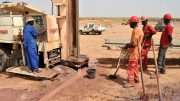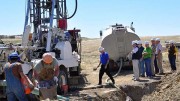The free fall of the Canadian dollar, which has only accelerated in 2014, undoubtedly has the CFOs of Canada’s mining companies breaking out the spreadsheets and tallying up the pluses and minuses of the new, low-loonie environment.
Goodbye simple calculations that assumed parity between the Canadian and U.S. dollars, as the loonie has slid over 9% in the past year.
At press time, the Canadian dollar was trading at US90¢, and on Jan. 27, the Canadian dollar slipped below that level for the first time since July 2009, as the U.S. dollar surged and currencies of emerging-market and resource-exporting countries contracted sharply.
These currency devaluations triggered round after round of selling in emerging countries’ stock and bond markets, and a simultaneous flight to safety in U.S. dollars, stocks and bonds.
Turkey grabbed the biggest headlines worldwide, as the lira hit a record low against the U.S. dollar, prompting the Turkish central bank to convene an emergency meeting and vow to defend the lira with steep interest-rate hikes.
Back in Canada, many currency analysts are predicting the loonie could tumble into the mid-US80¢ range in the near- to mid-term, causing people to remember those days around the turn of the millennium when the Canadian dollar limped along around the US65¢ level.
A slew of factors have been jostling the world’s currencies of late, adding a new layer of volatility to a global economy still on the mend from the 2008 flash crash.
Key factors in the loonie–greenback dynamic have included: mixed economic data out of the U.S.; the U.S. Federal Reserve’s decision in late January to taper its bond purchases by another US$10 billion a month, to US$65 billion a month; expectations of lower growth rates of the Chinese economy; new concern over the health of Chinese banks; weak prices for many commodities, including oil and gas; and unspectacular earnings reports from Canadian companies.
Contrary to many analysts’ expectations, gold has fared well despite this recent surge in the U.S. dollar, trading at US$1,267 per oz. at press time and enjoying a London AM fix as high as US$1,270 per oz. on Jan. 27. This compares with the Dec. 31, 2013, close of US$1,201.50 — in other words, the gold price has risen 5.7% so far this year in U.S. dollars.
Gold mining companies with operations in Canada who report earnings in Canadian dollars are reaping the dual benefits of the sinking loonie and rising gold price, something that will take a more real form as first-quarter earnings are released around May.
While a sinking loonie translates to lower labour and local expense costs in Canada, just as obviously, in the longer term, the same operations can suffer pressure as foreign-sourced, U.S.-priced materials and equipment become more expensive.
Some of these feasibility studies completed in recent years for large mining projects in Canada will also need a second look, as many assumed parity between the Canadian and U.S. dollars — an assumption that made sense as recently as 2010.
• One of the unofficial kickoffs to any new year in mining is the Vancouver Resource Investment Conference, put on by Cambridge House International in the Vancouver Convention Centre every January.
If you could characterize the mood there this year, it would be one of new, cautious optimism, reminiscent of green shoots appearing after a forest fire.
The last two and a half years of financial pain in the junior-mining sector has ground down just about everyone active in it to some extent, but the general feeling at the show — expressed both at the podium and informally around the booths — was that the recovery will happen, if not this year, then next year at the latest.
Most speakers expressed the gut feeling that gold prices had bottomed, and many pointed to zinc more than any other commodity as probably the one with the best supply–demand fundamentals this year, from a miner’s perspective.




Be the first to comment on "Editorial: Falling loonie resets expectations"